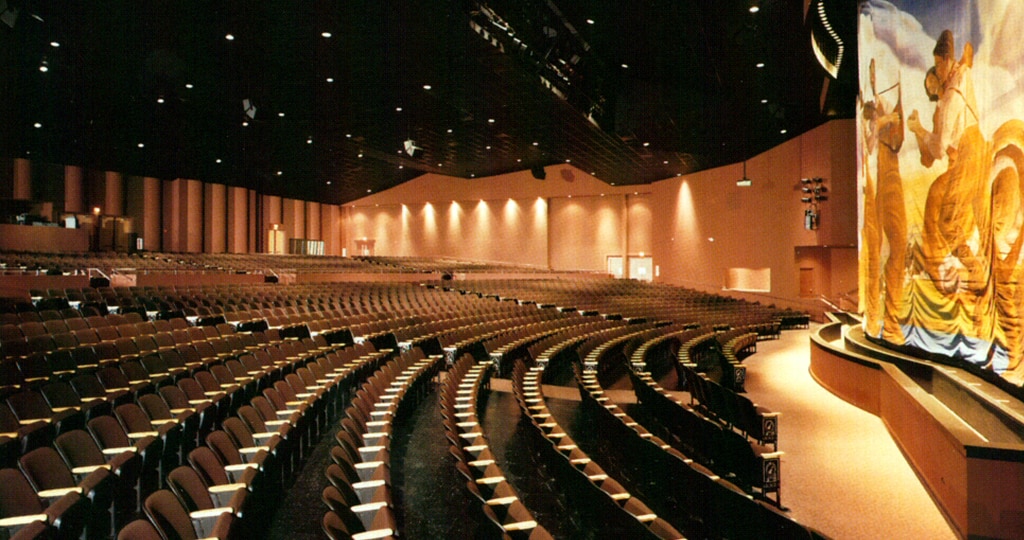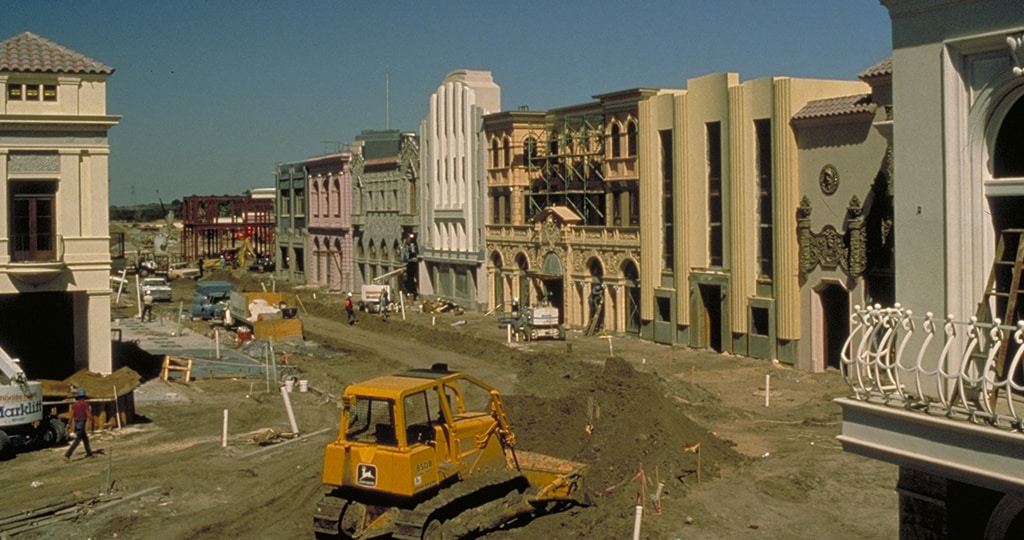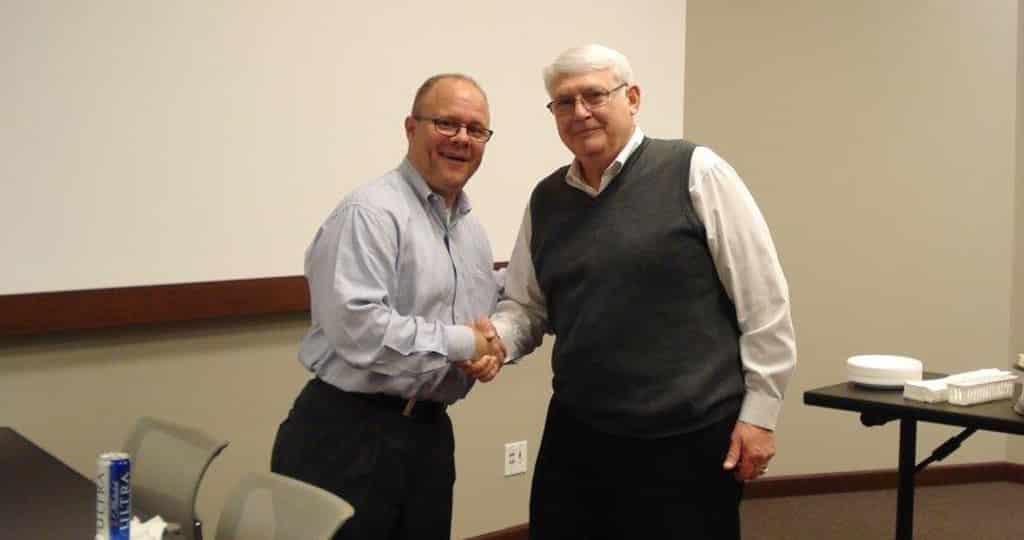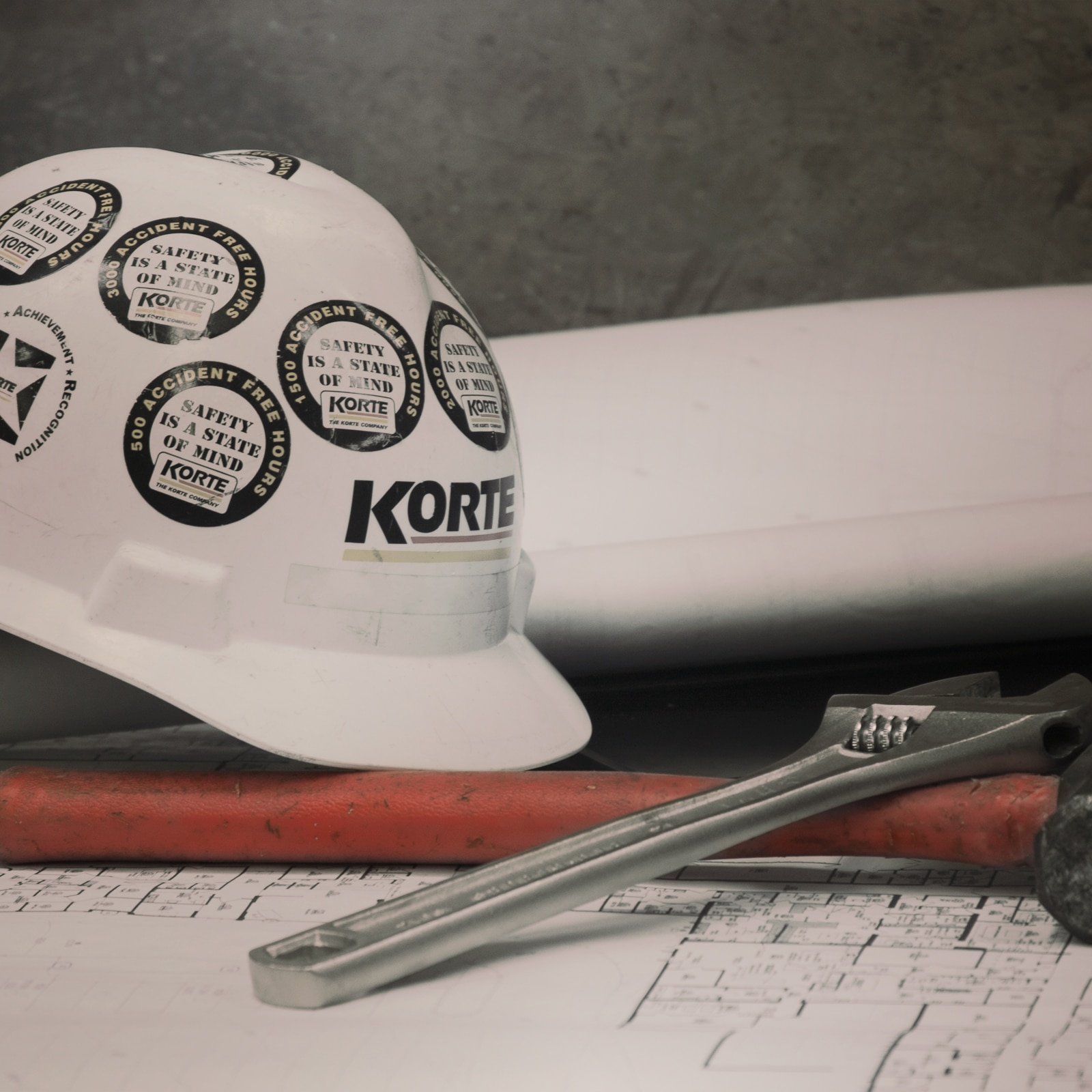When Tom Lyerla and his wife Cheri would take their three daughters shopping, he’d often hang back from any discussions of blouses, shoes and accessories. Instead, he’d rove the perimeter of the store, checking for smooth drywall, seamless flooring transitions and thinking about how he’d have done the project differently.
And that’s just off the jobsite.
As Tom rose from carpenter apprentice to project executive over his 37-year career at The Korte Company, he held every inch of every project to the highest standards. He was the hands-on guy, the project manager on the ground, checking for caulk overrun or cracked drywall—and making sure it got fixed.
The buck stopped with Tom, and Korte jobs were better for it.
Learning to lead
Before he oversaw hundreds of thousands of square feet in projects, Tom’s introduction to construction started at home. He helped his father update the painting, remodel the siding and perform electrical work at their Collinsville, Illinois home.
“My three other brothers weren’t interested in it, but I was. I understood construction from an early life of helping my dad.”
Tom entertained himself as many young boys did growing up in the 1950s and 60s: a robust rotation of outdoor games. Capture the flag, hide and seek, croquet and, of course, baseball. A nearby empty lot served as home field, with Tom in the outfield or as pitcher. They acquired gloves and bats from the local Ben Franklin or another five-and-dime, and used whatever they could find for makeshift baseballs.
“We would take a practice golf ball and wrap it in foil and white tape, and that’s what we pitched.”
The local chapter of the DeMolay youth organization also served as an important gathering place for the Lyerla boys. The group, similar to Cub Scouts or 4-H, focused on community involvement and sent the young men to volunteer as clean-up for local fundraising dinners or assemble meal packages for those in need during the holiday season. Tom and his brothers all served terms as Master Conciliar (essentially the president) of their local chapter.
“DeMolay taught me leadership and respect and honor. It gave me an early start on understanding how to develop goals for yourself. We all four believed in it, and as well as other family members and other people in the community.”
A precedent for career goals had already been set in Tom’s family: working for the railroad. His father, a railroad engineer for the Cotton Belt Railroad. His uncle, a dispatcher for the Illinois Central. His grandfathers on both sides, railroad telegraphers.
For Tom’s father, “the railroad was his life.” But Tom knew his future lay elsewhere.
“From an early age, I enjoyed construction. I would sit and draw things when I was young. I didn’t know it at the time how things would end up from the very fortunate meeting with Ralph Korte.”
“I was always up for a challenge”
The summer after graduating high school, Tom and his brother found summer jobs in the marketing and records departments at Monsanto. He helped with sales brochures, file retrieval and intra-company mail while taking general education classes at South Western Illinois College. His next position came from the Nestlé Company location in Granite City, where he did warehouse work and tested tea quality in the lab.
None of it held Tom’s interest.
So he marched down to the carpenters’ union hall and applied as an apprentice, ready to learn a trade and return to his construction roots. He immediately stood out to the apprentice board for his age. Most applicants were fresh out of high school. Tom was 25. But it was his drive that caught the attention of Ralph Korte, who sat on the board at the time.
“We talked about what I was doing and Ralph said, ‘Someday I want you to give me a call.’”
Tom took that advice right away and called Ralph for two weeks until he heard back. That led to an opportunity to interview with Ralph’s cohorts Vern Eardley and Larry Korte. Tom then started in 1976 as an apprentice carpenter for The Korte Company.
And so began a career-long tradition of Tom seeing chances to grow—and seizing them.
“If Ralph and Vern gave you opportunities, it was up to you to prove to them and to yourself that you wanted to advance, that you weren’t satisfied with just doing something. And I was always up for a challenge.”
He cut his teeth as a carpenter for The Korte Company on an apartment complex in Greenville, Illinois and a Knights of Columbus hall in Highland, Illinois. And when Ralph and Vern asked Tom if he’d consider traveling, Tom responded, “That’s fine with me.”
The out-of-town job took him to Kansas City for a restaurant chain called Chutes, which delivered food by pneumatic tube—just like at the bank drive-through, but for hamburgers, fries or their signature “Chute the Works” sandwich.
“I built the very first one. It was funny to watch the operations begin because at first, we had soda everywhere. A pneumatic tray would go underground, then would rise up in a kiosk with an elevator, and then your food and drinks would all be in a box. I’ll never forget those jobs.”
On his return to Illinois, he started on a wastewater treatment plant for the city of Highland. It was a brutal job with cold winds, snow and icy working conditions, but Tom dug deep and worked through it. Around the same time, higher-ups took note of Tom’s potential for leadership, though he was only a year into his career at the company.
When given the chance after the wastewater treatment job to leave the union, become salaried and move to office work, Tom once again said yes. He started as an assistant project manager and was soon promoted to project manager in 1984.
“I don’t look back on giving up my carpentry work.”
Tom’s responsibility grew to not just include precisely measured, cut and assembled boards, but precisely managed carpentry, cement and electrical crews, too. Project management also calls for fielding subcontractor bids, taking care of bonds and insurance and working with the unpredictability of weather.
It’s a hundred moving targets with the same bullseye—get the job done. The challenge once again suited Tom.
“Ultimately the goal is to get your clients happy. If I’d get frustrated with subcontractors, I’d say ‘You know, you’ve got to remember one thing. If you didn’t have this client, you won’t have a job.’”
Setting the stage
Glen Campbell, a country and pop artist and singer of “Rhinestone Cowboy”, sought his own performance venue in Branson, Missouri (the Ozarks’ answer to Vegas-style shows and acts). The Korte Company took on the job for the Glen Campbell Goodtime Theatre—tight deadline and all.
“We were hired October 2, 1993. We didn’t have a footprint until November 29. Then they said they wanted Glen Campbell to sing on June 4 of the next year. And we didn’t have steel, and we were still blasting rock.”
The Korte Company got right to work on the steel and brick veneer structure. The 2,200-seat theatre included a gift shop, ticket booths, a concession area as well as giant video monitors and a rain curtain to boot. Tom remained “hands on” throughout the process and ensured accurate scheduling, good participation and commitment from everyone on the job.
As June approached, Glen would practice his act as Tom and the crew put finishing touches on the venue. After all, they both had deadlines to meet.

Right on schedule, Glen and the band performed in the new venue on June 4. And for a satisfying encore, the city of Branson awarded The Korte Company the first annual Building Safety Award for outstanding achievement in jobsite safety.
Tom also took home some personal mementos from the quick-turnaround undertaking.
“I have pictures of Glen and my family and some of our co-workers, and I’ve got a hard hat that Glen and the band signed. I didn’t know they were doing it when he gave it to me. My wife actually has it under glass in my workshop. It gave me a way to go back feeling really proud of what I was doing.”
He showed his managerial merit on another entertainment venue, albeit with a larger scale: the new Universal Studios theme park in Orlando, Florida. The Korte Company won the contract for “The Front Lot” and appointed Tom as project executive for the high profile job.
The project required tight security (nearby, Disney was building MGM Studios) and precise coordination with the 4 other contractors who were completing other sections of the theme park. Tom and his crew built areas including the main entry plaza, The Universal Studios Store, VIP Plaza and the iconic Globe Fountain.
Constant design modifications from the Universal Studios architects kept Tom on his toes; he had two estimators on site just to stay abreast of the changes.
“It was quite monumental to keep track of everything and remain on top of it.”
One of the late-in-game decisions including the replanting of an on-site tree for the VIP Plaza. This involved digging it up, wrapping it in burlap then hoisting the 18-inch diameter tree over an in-progress building right into a giant planter.
As the park opening approached, Tom knocked down the punch list to a mere half-page of final to-do’s (comparably tiny for such a large venture). Everything was ready, down to the verdant leaves of the 40-foot-tall palm trees to evoke the signature palm-lined Hollywood Boulevard.

Tom, Cheri, her parents and their three girls (7, 10 and 11 at the time) were among the first to enjoy the new amusement park.
“We got to enjoy the opening of the park and all of the fanfare. That was very enjoyable and very memorable.”
Through all the tight deadlines and last-minute changes, Tom reaffirmed that none of it was achievable without the team-focused approach of the Design-Build method.
“What made Design-Build such a fascination for me was that it brought all of our team together. There was no single person you could say was the success for that project. You could never not take your architects or your estimators to the meeting, you would always have them as part of the team. Once you put everybody together, then you’ve got this big group of people who could feed off each other, and that was the key thing.”

“At the end of the day, did you make sure it was right?”
Project managers complete punch lists as standard practice on any jobsite. When tradesmen say they’re done with their portion of the work, project managers like Tom would go back and make sure it met standards. No spilled paint, no caulk overruns, no split board, no cracked drywall.
Tom earned the reputation of being “one of the worst punch list people”—meaning if there was an imperfection, he caught it.
After all, the success of any one project relies on every single individual doing good work, day in and day out. It’s the core of project management: Not just holding high individual standards, but making sure every subcontractor under your watch does the same.
“On rare occasions you would have to put your foot down. But most times you try to work with them and understand what their problem is. Not bail them out, but understand what you can do to help them get the project done.”
In 1984 Tom moved into the executive suite as an assistant vice president, and eventually earned the title of Senior VP. He additionally led a special estimating task force, where a small team would swiftly assemble estimates for clients in the early bidding stage.
The team started with basics: a preliminary foundation cost, carpet or tiling costs based on the square footage, and so on. Instead of estimates taking the standard two to three weeks, Tom and his team could put together a number in as fast as three days.
This not only freed up the estimating department, but laid the groundwork for nurturing the client relationship right away. And for a company that earns more than 84% of its work come from repeat business, that was invaluable.
No matter what role he played, from laying planks and driving nails to facilitating a streamlined estimation process, Tom relentlessly pursued the best work.
“When you get a chance to help develop the client’s dream, that’s when it was fun. And you relish the fact at the end of the day when you do the groundbreaking or cut the ribbon, I found myself totally satisfied that we did a job well done. Did everything go right? Not always. But at the end of the day did you make sure that it was right? That was my goal every time.”
“The best thing that came out of my career”
At the onset of Tom’s four-decade career, it took him less than a year to recognize his potential longevity with The Korte Company.
“Once I was a part of the team, you could see there was always that camaraderie, that respect and a feeling of net worth. I looked at it as, ‘I can make a difference here,’ and I wanted to be a part of that.”
Company sleigh rides in the winter, picnics in the summer and the warm efforts of Ralph and his wife Donna continued that camaraderie over the course of Tom’s career. And even in retirement (Tom retired in April of 2013) it continues with a group of former co-workers who gather for a handful of dinners each year to reminisce.
Today, Tom and Cheri reside in Marine, Illinois and have already knocked Alaska off their retirement travel bucket list. Next up is Great Britain, where Cheri hopes to visit Highclere Castle of the Downton Abbey TV show’s fame.
Many years removed from his father’s remodeling tasks around the house, Tom still finds himself pulled into projects—this time by his own kids.
“It’s amazing what your kids can find you to do for them. Whether they’re telling you, ‘Help build a family room,’ or, ‘Help babysit,’ or, ‘Help with this landscaping project.’”
He built an in-ground pool about a decade ago, and it has since served as the go-to destination for their eight grandchildren during the summer months. The grandkids call him “Grandpa” (except for the youngest, who’s still stuck on “Paw Paw”), which Tom designates as “one of the best titles I got.”

Looking back on his 37 years at the company, it would be easy to say that Tom’s most important chance encounter was running into Ralph Korte at the carpenters’ union hall all those years ago. But that has to take second place, as Tom met Cheri through The Korte Company, too.
Back when Tom was still doing carpentry work for The Korte Company, Cheri had also worked there as a receptionist and the two had seen each other around the office. Several months later, a happenstance meeting in Kansas City crossed their paths again, “like two ships in the sea.”
And the rest, as they say, is history.
“The best thing that came out of my career was Cheri—43 years, eight grandkids later. As I advanced in the company, she was by my side every day. The culmination of everything that my life is about is us together.”
